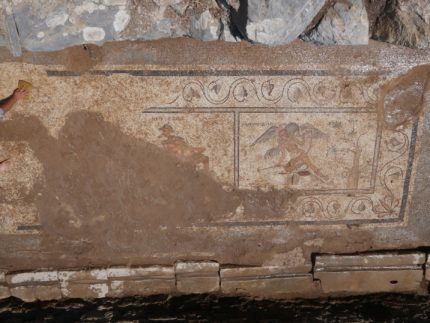A ribald mosaic has been discovered in a Roman latrine at the ancient site of Antiochia ad Cragum near modern-day Guney on the southern coast of Turkey. The mosaic covered the floor of the 2nd century A.D. latrine, providing some visual entertainment for the gents as they made use of the public facilities. It was rather naughty entertainment at that, a good fit for the environment.
The mosaic consists of two mythological scenes that don’t exactly cleave to the Bullfinch versions. One is of Narcissus, only instead of being entranced by the reflection of his beautiful visage, he is entranced by his beautiful phallus. The second features Ganymede, described in the Illiad “the handsomest mortal man on earth,” a youth so beautiful that Zeus took the form of an eagle and carried him away to Olympus to serve as his cupbearer. The mosaic flips that account and depicts Ganymede having his genitalia sponged clean by a bird.
“We were stunned at what we were looking at,” said Michael Hoff, an archaeologist at the University of Nebraska-Lincoln. “You have to understand the myths to make it really come alive, but bathroom humor is kind of universal as it turns out.” […]
Narcissus is shown with an uncharacteristically long nose, which would have been considered ugly by the beauty standards of the time. He looks down, presumably admiring the reflection of his conspicuous penis instead of his face.
In myth, Zeus disguised himself as an eagle to kidnap the Trojan adolescent Ganymede and make him a cupbearer to the gods. (The myth offered a model for relationships between men and adolescent boys in ancient Greece.) In art depicting that abduction, Ganymede is often shown holding a stick and rolling hoop as a toy.
In the image in the latrine, Ganymede instead holds tongs with a sponge, a reference to the sponges that would have been used for wiping the toilet. And Zeus is not an eagle but a heron, with a long beak grasping a sponge and dabbing Ganymede’s penis.
“Instantly, anybody who would have seen that image would have seen the [visual] pun,” said Hoff. “Is it indicative of cleaning the genitals prior to a sex act or after a sex act? That’s a question I cannot answer, and it might have been ambiguous then.”
The floor was discovered on the last days of this season’s excavation of Antiochia ad Cragum. The University of Nebraska team has been excavating the ancient city, built in the 1st century A.D. by Roman client king Antiochus IV of Commagene, since 2005. An enormous mosaic from the public baths made international news when it was discovered in 2012, and another large floor mosaic was discovered in an adjacent temple the next year. They were geometric and floral in pattern, however, whereas the latrine mosaic is figural. Naughty Narcissus and Gamy Ganymede are the only examples of figurative mosaics found thus far at Antiochia ad Cragum.

The “problem” that names of different locations (‘Antioch’, ‘Kragos’) are given several times, is still common in what is left of Greece.
The acropolis of ‘Antiochia ad Cragum’ is really impressive (and presumably older), but the mountain ist not the ‘Kragos’, i.e. the local one, or is it? :confused: